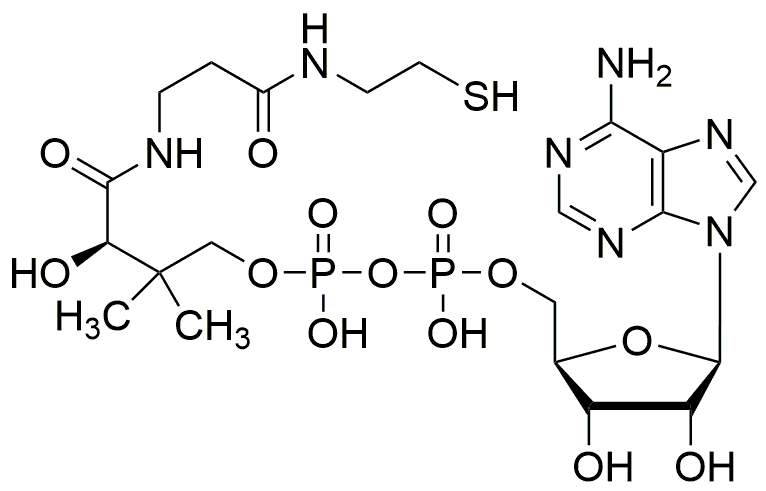3'-Dephosphocoenzyme A is widely utilized in research focused on:
- Biochemical Research: This compound plays a crucial role in studying metabolic pathways, particularly in the synthesis and regulation of coenzymes, helping researchers understand cellular energy processes.
- Pharmaceutical Development: It is significant in drug formulation, especially for medications targeting metabolic disorders, providing insights into how drugs interact with coenzyme systems.
- Enzyme Activity Studies: Researchers use this compound to investigate enzyme kinetics and mechanisms, offering a clearer picture of how enzymes function and their potential inhibitors.
- Biotechnology Applications: In the field of synthetic biology, it aids in the design of metabolic engineering strategies, allowing for the optimization of microbial production of valuable compounds.
- Clinical Diagnostics: Its role in metabolic pathways makes it a candidate for developing diagnostic tools to identify metabolic dysfunctions, enhancing patient care through early detection.
Informations générales
Propriétés
Sécurité et réglementation
Applications
3'-Dephosphocoenzyme A is widely utilized in research focused on:
- Biochemical Research: This compound plays a crucial role in studying metabolic pathways, particularly in the synthesis and regulation of coenzymes, helping researchers understand cellular energy processes.
- Pharmaceutical Development: It is significant in drug formulation, especially for medications targeting metabolic disorders, providing insights into how drugs interact with coenzyme systems.
- Enzyme Activity Studies: Researchers use this compound to investigate enzyme kinetics and mechanisms, offering a clearer picture of how enzymes function and their potential inhibitors.
- Biotechnology Applications: In the field of synthetic biology, it aids in the design of metabolic engineering strategies, allowing for the optimization of microbial production of valuable compounds.
- Clinical Diagnostics: Its role in metabolic pathways makes it a candidate for developing diagnostic tools to identify metabolic dysfunctions, enhancing patient care through early detection.
Documents
Fiches de données de sécurité (FDS)
La FDS fournit des informations de sécurité complètes sur la manipulation, le stockage et l’élimination du produit.
Spécifications du produit (PS)
Le PS fournit une description complète des propriétés du produit, notamment sa composition chimique, son état physique, sa pureté et les exigences de stockage. Il détaille également les plages de qualité acceptables et les applications prévues du produit.
Certificats d'analyse (COA)
Recherchez des certificats d'analyse (COA) en saisissant le numéro de lot du produit. Les numéros de lot et de lot se trouvent sur l'étiquette d'un produit, après les mots « Lot » ou « Lot de fabrication ».
Numéro de catalogue
Numéro de lot/série
Certificats d'origine (COO)
Ce certificat d'exploitation confirme le pays dans lequel le produit a été fabriqué, et détaille également les matériaux et composants utilisés et s'il est issu de sources naturelles, synthétiques ou autres sources spécifiques. Ce certificat peut être requis pour les douanes, le commerce et la conformité réglementaire.
Numéro de catalogue
Numéro de lot/série
Fiches de données de sécurité (FDS)
La FDS fournit des informations de sécurité complètes sur la manipulation, le stockage et l’élimination du produit.
DownloadSpécifications du produit (PS)
Le PS fournit une description complète des propriétés du produit, notamment sa composition chimique, son état physique, sa pureté et les exigences de stockage. Il détaille également les plages de qualité acceptables et les applications prévues du produit.
DownloadCertificats d'analyse (COA)
Recherchez des certificats d'analyse (COA) en saisissant le numéro de lot du produit. Les numéros de lot et de lot se trouvent sur l'étiquette d'un produit, après les mots « Lot » ou « Lot de fabrication ».
Numéro de catalogue
Numéro de lot/série
Certificats d'origine (COO)
Ce certificat d'exploitation confirme le pays dans lequel le produit a été fabriqué, et détaille également les matériaux et composants utilisés et s'il est issu de sources naturelles, synthétiques ou autres sources spécifiques. Ce certificat peut être requis pour les douanes, le commerce et la conformité réglementaire.


